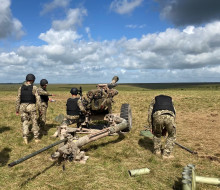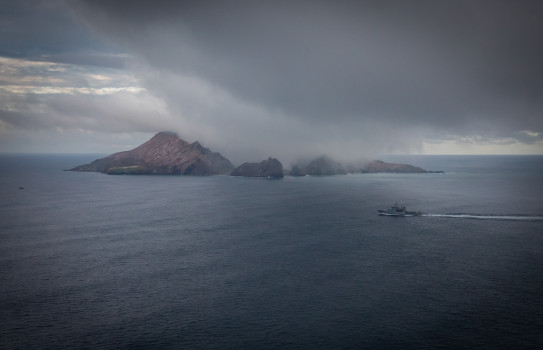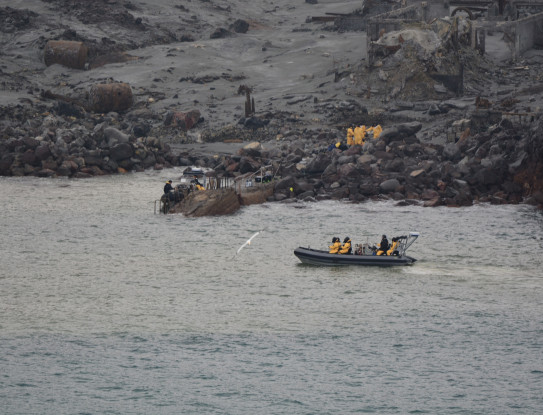
Defence Force recognises personnel going the extra yard at home and abroad
10 April 2024
Unfortunately you are viewing this website on an outdated browser which does not support the necessary features for us to provide an adequate experience. Please switch to a modern browser such as latest version of Google Chrome, Mozilla Firefox, Apple Safari or Microsoft Edge.
Ngā mihi nui
Whakaari / White Island
At 2.11pm, Monday, 9 December 2019, Whakaari/White Island erupts. At the time of the eruption, there are 47 people on the island. Tourists and guides are caught up in the explosive event.
9 December 2019
Within minutes, military personnel who plan operations in New Zealand and overseas, gather at the NZDF’s Headquarters Joint Forces New Zealand (HQJFNZ) to build a picture of the problem and determine what assets and personnel can be deployed to support the recovery effort.
As soon as word of the eruption comes through, HMNZS Wellington in Auckland is made ready to go to sea. Once its helicopter has embarked, the ship ‘sprints’ at 22 knots for White Island. Wellington becomes the key platform from which operations onto the island are conducted and controlled.

HMNZS Wellington off the coast of Whaakari/White Island
11 December 2019
The elite Littoral Warfare Team from HMNZS Matataua, made up of diving and hydrographic specialists, forward deploy into the Bay of Plenty area complete with Autonomous Underwater Vehicle (AUV) and recompression chamber. By Wednesday the AUV is transported onto HMNZS Wellington and is conducting underwater searches of White Island.
12 December 2019
On Thursday evening and into the early hours of the following morning, Rigid Hulled Inflatable Boats (RHIBs) are used to pre-position the Explosive Ordnance Disposal (EOD) Squadron Recovery Team, a decontamination team and medical specialists, from Whakatāne onto HMNZS Wellington.
13 December 2019
The victim recovery operation begins early in the morning. HMNZS Wellington’s two RHIBs are lowered into the water and recovery team stores are moved onto the landing at White Island. Once on the island, the recovery team drag their equipment on sleds and on their backs toward the known locations of the people killed in the eruption. Working in deep, sticky, toxic sludge the recovery team locates the victims and moves them one by one to a suitable point for helicopter uplift.
Two RHIBs are lowered into the water and recovery team stores are moved onto the landing at White Island.

White Island recovery
After 90 minutes, the team are exhausted and return to the landing to regroup, rehydrate and cool off. They make a deliberate decision to not give up and push through to achieve the mission. Throughout the mission a Seasprite helicopter circles overhead and as it runs low on fuel a second Seasprite arrives from Whakatāne to assume the overwatch role. Finally word comes through that the recovery team has completed its work and the NH90 helicopters move in, taking two trips to move the victims onto HMNZS Wellington.
Two Seasprite helicopters begin the process of moving the victims, one at a time, back to Whakatāne airport. Finally the victims are reunited with their families and after some shared grieving, the bodies are loaded into two NH90 helicopters to be moved to Auckland where the Disaster Victim Identification (DVI) teams go to work.
The risks were very real. One of the go/no-go criteria for recovery was that there needed to be a 6 percent or less chance of death at the task site if an eruption were to occur in a three-hour window.
At the time, GNS were saying there was a 40-60 percent chance of another eruption in a 24-hour period.
Despite all of the risks and challenges, the Navy and other Defence Force personnel and capabilities involved are able to overcome those issues, making a difference to alleviate the suffering of victims, their families and friends.
Together we protect New Zealand’s interests at sea. Our Navy carries out a range of tasks including combat operations, search and rescue, underwater recovery, trade protection and peacekeeping. Whatever the mission, you’ll find that there’s a real tight-knit camaraderie whether you’re at sea, at home or abroad.
Find out moreOur other areas of work